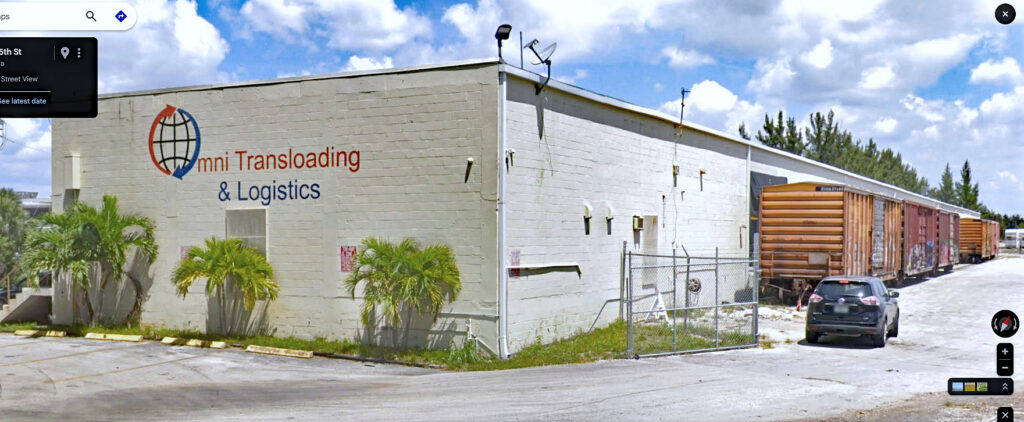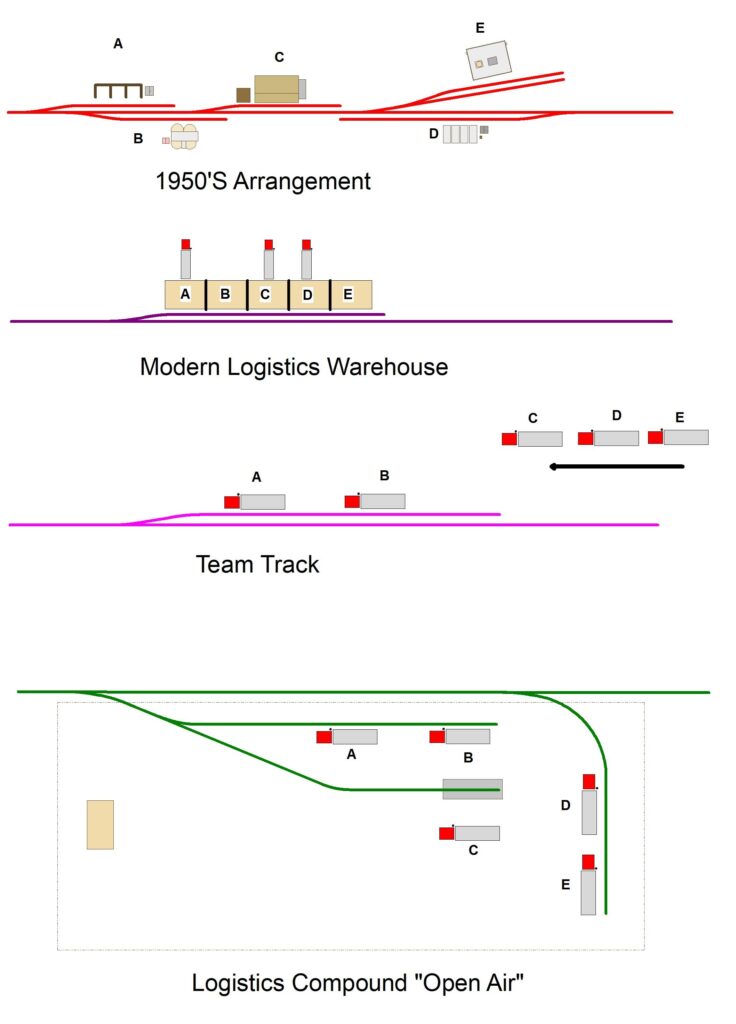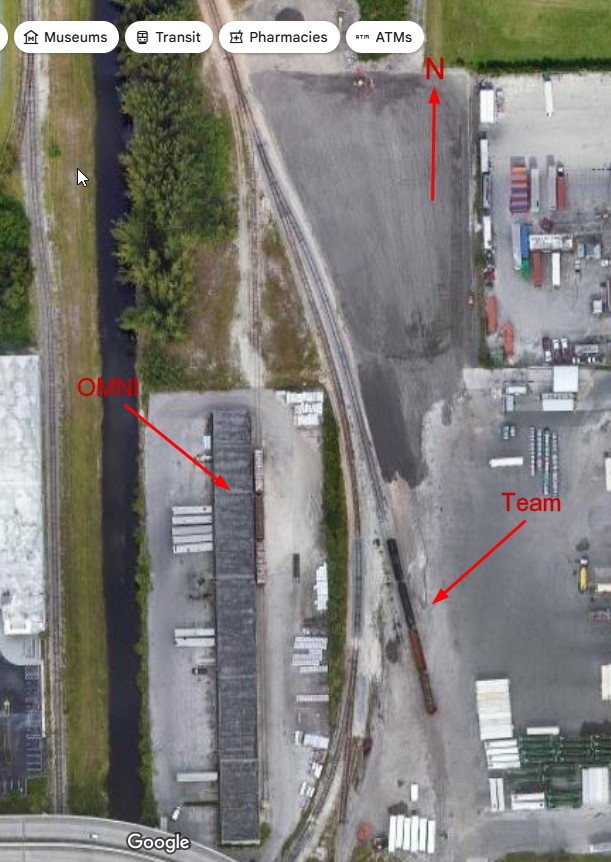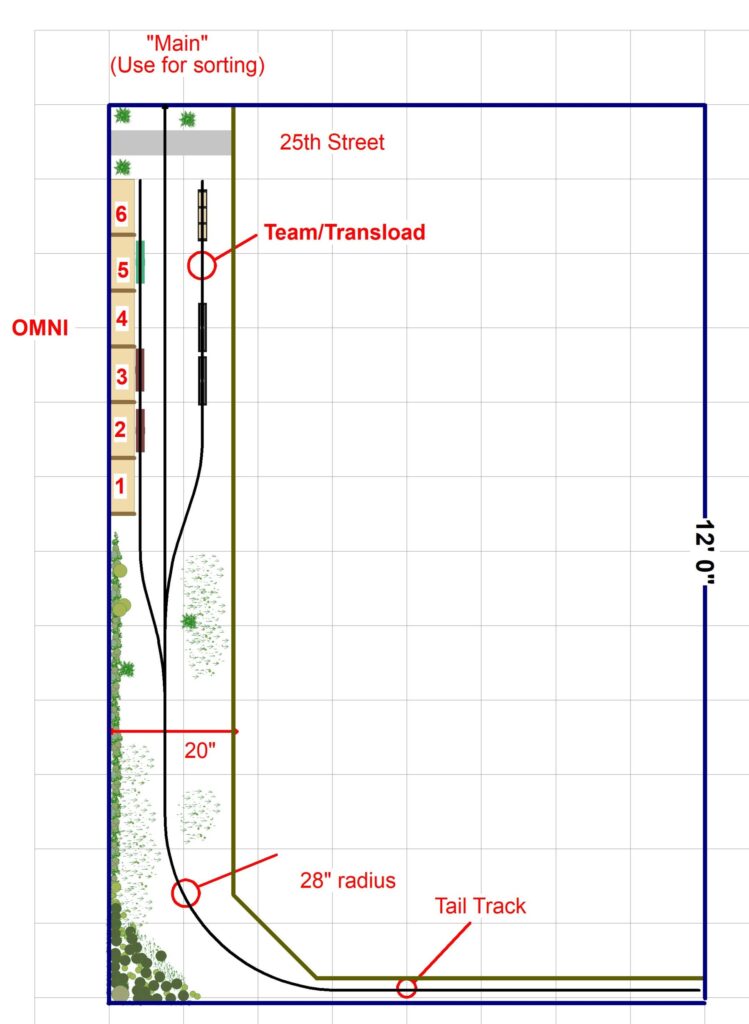
OMNI Transload in Miami’s Commerce Park Industrial zone next to the airport (several hundred yards west of runway 8R). Although it’s one structure, it’s broken down into individual spaces, each leased to a different tenant. In effect, each of those cars serves a different customer. (Thanks to “Mr. Miami”, Tolga Erbora for bringing this operation to my attention.)
Yesterday is gone. The wonder of the 1950s is now seven decades in the past. Let’s shed one last tear, stop staring in the rearview mirror, look at the road in front of us, and open our eyes to the amazing modeling opportunities modern railroading is presenting to us. From a design standpoint, we are decades overdue in terms of taking the time-worn, horrid, bowls of spaghetti of the past and putting them where they belong, in the memory book.

The diagram above shows the evolution of how railroads serve smaller customers. In earlier eras, small customers usually had their own spur. They now lease space in a logistics warehouse or send a truck to a team track to unload their product. From a modeling standpoint the “modern system” is easier to represent and allows you to insert more customers in a smaller amount of space.
If you asked most modelers if the number of rail-served industries has decreased, the overwhelming majority would say yes. That’s partly true but, if you look beneath the surface, a more accurate assessment would be that of change. Without question, the number of industries with their own spur has greatly diminished. However, that doesn’t necessarily mean they’ve stopped getting rail service. In simple terms, what’s happened is that the railroads have said, let’s strike a middle ground here where we both benefit. We’ll still give you rail service. For it to work, we need to trim the infrastructure of those spider web spurs. If you will come to us, or a central location, you can still ship by rail. The nature of these smaller rail-served industries has changed, but the volume hasn’t decreased as much as you might think. And, therein lies an opportunity. Whether it fits for you will depend on how critical the old “building with a spur” in front is to you. What we have now is a system of team tracks, logistics warehouses, logistics compounds, and transload facilities.

Team track spurs often have a fairly generous length. This means they can serve a number of customers at once. Looking at the spur above, it’s clear that cars for two distinct customers are on the lead. On a different day, you’d also see centerbeams of lumber or hoppers of plastic pellets. Note that in modern times they’ve largely gotten away from loading platforms. Trucks just pull up next to the cars.

Here’s an aerial view of OMNI Transload in Commerce Park with an adjacent team track. On this day the team track had two tank cars and two scrap gons.

Logistics warehouses are the perfect industry for a model railroad. You get a lot of industries in a small amount of space. Common business renting space in them includes: lumber, frozen food, wine, and dry goods. They offer a lot of operational interest as well since an incoming cut of cars needs to be sorted and spotted in front of the correct customers.

The above design addresses today’s world, a world of efficiency. We only need two turnouts to serve what amounts to eight customers, six at OMNI and two on the team track spur. Operations are challenging, both in real life and for the modeler. Incoming cars need to be sorted correctly before spotting. The prototype would either do this in the yard ahead of time or use the “main” as a sorting track. Then, there’s the issue of the ever-present “problem” customer that GM’s complain about. The one that takes FOREVER to unload their car. Your train comes in with new cars but there’s always that one car in front of the warehouse that hasn’t been unloaded. This means you need to pull it, spot the incoming cars, and then put the problem customer’s car back.
A layout like this checks a lot of boxes:
-Plausible
-Operationally interesting
-Visually interesting
-Inexpensive and easy to build
It offers access to the hobby for anybody ranging from a motivated young student, a busy young person launching their career and starting a family, to a diehard “gray haired” prototype modeler like myself.
Let’s stop bitching about what once was and embrace the fascinating rail world that lies before us.
Best blog post! Great explanation and illustration of the benefits of modern era industrial switching. The sample track plan is just icing on the cake.
Great article and appealing, simple design, Lance. Question — would service to the two sites be a shove move northbbound, or be a southbound move with locomotive then reversing to serve sites? Any prototypical insights?
Thanks Mark. I’m not familiar enough with the FEC’s operations to answer your question. Sorry.
I love the idea of a logistics warehouse, I’m actually planning on adding one to my layout, as sorting cars and doing re-spots adds so much to the realism and operations.
I would push back a little bit on the idea that the 1950’s had a track for every customer- there were many cases with several customers on one track, but they were separate businesses as opposed to team tracks or logistics warehouses like are more common today.
I’d also note that while there are likely more companies today using rail service than ever, the majority of them are using intermodal, which is kind of boring to model. Intermodal is very efficient for the railroads, and thus boring for the modelers. There is still plenty to love about modern carload railroading, and plenty to put on a model railroad.
I have never posted on your site before Lance, but greatly admired your Monon layout, and wish it could have been finished before dismantling.
While some may lament the loss of what was, railroad wise (and yes, we did lose a lot), I think the average modeler that prefers an earlier era might have several reasons for this.
As an architect, modeling say the 1940’s to the early or mid 1950’s might be a chance to capture the drama of Class I railroading, when passenger trains were at their zenith, and more importantly the classical & historic architecture of that period is a great backdrop for that action. Personally as I drive around Boston where I have lived since age 19, what I see doesn’t interest me as much.
Narrow gauge or TOC modelers don’t have a modern equivalent with today’s rail lines, as those systems became obsolete eventually. However there is some appeal to having a time capsule layout as a means to escape or replicate a simpler era, without all the detailing that a modern layout would demand (fencing, graffiti, signage, road traffic striping, etc). Personally I see nothing wrong with that.
And for some, since the age of functionalism in design, the trains of today might lack some of the visual appeal of years past, as do buildings, autos, aircraft, etc. I for one really like Eric Brooman’s Utah Belt RR, but find his earlier era version much more interesting. Still modern when built (with 1970’s era equipment), but ever evolving to stay updated in today’s world. Admirable and interesting but the newer versions are a bit sterile in my opinion.
I live across the river from what used to be PanAm Railways, and I am not sure if it’s exclusively CSX now, but in 2019 there were about 12 trains per day running north to Portland ME, and south to Worchester MA, which are down to about 4-5 runs daily. Certainly not my type of railroading, yet still fun to watch & listen to.
Just my two cents, for what it’s worth
I don’t think people realize how engaged in the hobby they will become with a layout like this. However, they need to be real with themselves. If someone is looking at it and thinking they will get bored with it, they have missed the point of this layout. You can only lead a horse to water, you can’t make them drink. In a world of instant gratification, a layout such as this one, gives someone exactly that. instant ops! My one turnout layout (inspired by this blog) just turned 4, and has been the best thing I’ve ever done for myself in the hobby. It has kept me engaged in the hobby more than any organization or FB page. It provides me with 10-15 minute ops sessions. If I ask anything more of it, it will fail. Baby steps are key to making any kind of behavioral change. I’m thinking of graduating myself to this two turnout layout. My one turnout layout has served me well, but it’s time to build something again! Thanks for the motivation Lance!!